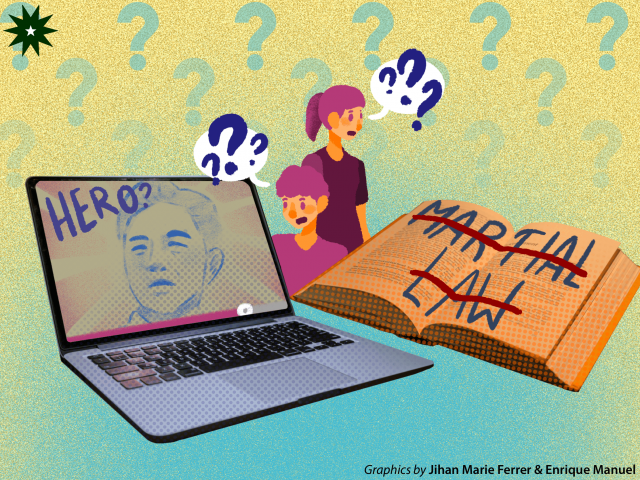
History, as public memory, is integral to a society. After all, how people perceive—or even deal with—the important events and figures in the past can shape the realities of the present. But public memory is not set in stone; people can deliberately change the facts and interpretations to influence the opinions of others.
Recently, a self-proclaimed “history vlogger” became viral after he claimed on his YouTube channel that atrocities in the Martial Law era were nothing more than a smear campaign against the Marcos family. Many decried his claims as “historical revisionism”, renewing interest and discussion on the topic.
Distorting the past
The terms “historical distortion” and “historical revisionism” tend to be used interchangeably when calling out lies or attempts to change historical fact. However, Jose Alain Austria, a History professor from the De La Salle-College of Saint Benilde, makes a clear distinction between the two.
“Historical revision, in itself, is neutral,” he explains, citing how new evidence, discoveries, and other research developments may bring about a need to revise what was previously taken as historical fact. On the other hand, historical distortion, is the “deliberate changing of the narrative in order to perpetuate a lie that would serve the interest of a person, a regime, an administration, [or] a dictatorship” with an intention of erasing a portion of history.
These distortive practices tend to come from those who “are taking advantage of [what they know is] a gap in the knowledge of people,” explains Dr. Jose Victor Torres, a Full Professor from the DLSU Department of History.
For instance, the Martial Law era, arguably one of the darkest periods in Philippine history, remains a hotly contested topic in the public eye because “not all people knew about the abuses during the time because of censorship,” explains Xiao Chua, an Assistant Prof. Lecturer from the University’s Department of History. By taking advantage of these knowledge gaps, the appeal of historical distortions is strengthened, giving them a heightened sense of legitimacy.
What makes these distortions dangerous, Austria says, is that it often feeds on what people want to hear about their country’s history. “We want to believe that there was once a time in the 1970s when the Philippines was allegedly the richest country in Asia,” he cites. “I was a kid at the time. I never experienced that kind of golden era.”
Torres remarks, moreover, that while some statements based on data may be true, one must also learn how to properly interpret the data “because if you just accept [it], it will create something that will also amount to a lie.”
“It is also the very reason why the Marcoses came back…Because [people] held onto the belief that the Marcoses were good,” he adds.
Another danger that these distortions pose, Austria says, is their ability to reshape public opinion and catalyze groups of people to take dangerous actions. He cites how in Rwanda, historical distortions through propaganda were used to seed hatred among ethnic groups, culminating into what is now known as the Rwandan genocide, which saw the mass slaughter of hundreds of thousands of people in 1994.
“We might find [historical distortions] very harmless right now, even funny,” Austria warns, “but if they fall into the wrong hands, it might get out of hand, and may lead to [some very] nasty [situations] such as civil discontent [or the] fall of a government.”
‘Educate, not humiliate’
The primary field of History that concerns itself with engaging with the public and battling these distortions is Public History, which Austria believes is an important countermovement as this makes History more accessible to the public outside an academic setting.
“The combat for historical truth is happening [on] YouTube [and] social media. [It is] about time for historians to leave their ivory towers and to go to this so-called battlefield,” he urges.
For Chua, bringing history closer to the people would mean simplifying key concepts to make an analysis and a narrative that is “more relatable” to the people without belittling them for their supposed ignorance of the topic.
“Educate, not humiliate,” Austria succinctly summarizes.
Though it might seem that distortions have become more mainstream and historical truth is largely ignored, Chua believes that historians must keep pushing forward and continue with their work.
“One person who thinks that you have a point in telling a more sober, judicious, and fair history is already one victory,” he says. “You have to implant this idea so that when the right time comes—that change will come, they are ready. So just create and create content.”
Do your research
While some may intentionally spread historical distortions, Torres argues that the blame falls “not only [on] the people who transmit the lie, but also [on] the people who receive the lie.” He adds, “The information has always been there in a click of a button; the problem is we don’t know how to use it.”
To catch these distortions, Chua emphasizes the importance of doing one’s own research, adding that people should question the source and reliability of a claim. “You don’t just share [information]. You have to be critical [of] what you share and what you believe,” he stresses.
Austria also adds that how an assertion is “packaged” also matters: if the headlines are catchy—“almost libelous, very personal”—and the ones making the claim cannot show their sources, then it is possible that the claim might not be true at all.
“We are now entering the post-truth era, wherein people are sick and tired of conventional truths,” he argues. “They are literally embracing lies, which would give them comfort, and what would lies give to you? Nothing. It will destroy you.”
